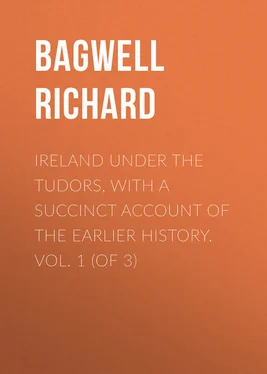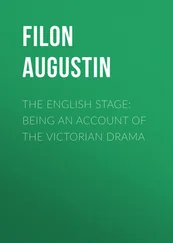Richard Bagwell - Ireland under the Tudors, with a Succinct Account of the Earlier History. Vol. 1 (of 3)
Здесь есть возможность читать онлайн «Richard Bagwell - Ireland under the Tudors, with a Succinct Account of the Earlier History. Vol. 1 (of 3)» — ознакомительный отрывок электронной книги совершенно бесплатно, а после прочтения отрывка купить полную версию. В некоторых случаях можно слушать аудио, скачать через торрент в формате fb2 и присутствует краткое содержание. Жанр: foreign_antique, foreign_prose, Историческая проза, на английском языке. Описание произведения, (предисловие) а так же отзывы посетителей доступны на портале библиотеки ЛибКат.
- Название:Ireland under the Tudors, with a Succinct Account of the Earlier History. Vol. 1 (of 3)
- Автор:
- Жанр:
- Год:неизвестен
- ISBN:нет данных
- Рейтинг книги:4 / 5. Голосов: 1
-
Избранное:Добавить в избранное
- Отзывы:
-
Ваша оценка:
- 80
- 1
- 2
- 3
- 4
- 5
Ireland under the Tudors, with a Succinct Account of the Earlier History. Vol. 1 (of 3): краткое содержание, описание и аннотация
Предлагаем к чтению аннотацию, описание, краткое содержание или предисловие (зависит от того, что написал сам автор книги «Ireland under the Tudors, with a Succinct Account of the Earlier History. Vol. 1 (of 3)»). Если вы не нашли необходимую информацию о книге — напишите в комментариях, мы постараемся отыскать её.
Ireland under the Tudors, with a Succinct Account of the Earlier History. Vol. 1 (of 3) — читать онлайн ознакомительный отрывок
Ниже представлен текст книги, разбитый по страницам. Система сохранения места последней прочитанной страницы, позволяет с удобством читать онлайн бесплатно книгу «Ireland under the Tudors, with a Succinct Account of the Earlier History. Vol. 1 (of 3)», без необходимости каждый раз заново искать на чём Вы остановились. Поставьте закладку, и сможете в любой момент перейти на страницу, на которой закончили чтение.
Интервал:
Закладка:
The connection of the Dublin Danes with their brethren in England had long been very close, and it was to Canterbury and Rome rather than to Armagh that they naturally turned. Sitric and Canute were perhaps in the Eternal City together; their visit was at least almost simultaneous, and we cannot doubt that every means were taken to prejudice the powerful neophyte against the pretensions of St. Patrick’s successor. An Ostman named Dunan or Donat is reckoned the first Bishop of Dublin, and is credited with the foundation of Christ Church. A tradition which may be true, but which is not supported by contemporary evidence, makes Sitric the joint founder. From an expression in the celebrated letter of the Dublin burgesses to Archbishop Ralph d’Eures it may be fairly inferred that Donat had his succession from Canterbury, and he certainly corresponded with Lanfranc on the subject of infant baptism. He was succeeded by Patrick or Gillapatrick, an Ostman, who was consecrated by Lanfranc in St. Paul’s at the instance of Godred Crovan, king of Man, who was then supreme at Dublin. Godred’s reign is rather shadowy, but Lanfranc’s letter to him has always been considered genuine, and it addresses him as king not only of Dublin, but of Ireland. Lanfranc also wrote to Tirlogh, who had acquired the supreme kingship, like his father, Brian Borumha. It is not unlikely that the curious poem which represents St. Patrick as blessing Dublin and its Danish inhabitants, and cursing the Hy Neill, was forged at this time, partly in the Munster interest and partly to prove that Dublin was not subject to Armagh. 25
In his letters Lanfranc insists much upon Catholic unity. According to modern ideas, the heaviest of the charges which he brings against the Irish Church is the levity with which they regarded the marriage tie. It appears that men even exchanged wives. Bishop Patrick promised ecclesiastical fealty to the Archbishop of Canterbury, as Primate of the British Isles. Lanfranc had obeyed the order of his old pupil Alexander II., who was prompted by the deacon Hildebrand, and had gone to Rome to receive his pall. But in his dealings with Dublin he acted independently, and he was ready to give advice to Irish prelates, though without claiming direct jurisdiction over them. In doctrinal matters he was an ally of Rome. Himself an Italian, he espoused the dogma of transubstantiation in opposition to the Irishman Erigena, and the Frenchman Berengarius; and on the great question of clerical celibacy he was a follower, though not an extreme one, of the uncompromising Hildebrand. The ever-watchful Roman Court probably espied the germ of a Western patriarchate, and was thus moved to annex Armagh as a counterpoise to the dangerous primacy claimed under a grant of Gregory the Great by the successors of Augustine. Gregory VII., in addressing the kings, nobles, and prelates of Ireland, took care to claim absolute sovereignty by divine right; and here he ran little risk of such a rebuff as William the Conqueror administered. 26
Patrick’s successor was Donat O’Haingly, an Irishman, but a Benedictine monk of Canterbury, who was consecrated by Lanfranc, to whom he had been recommended by King Tirlogh. He was succeeded by his nephew Samuel, a Benedictine of St. Albans, who was consecrated by Anselm. That great archbishop was not altogether pleased with his Irish brother, whom he chid for alienating vestments bestowed on the Church of Dublin by Lanfranc, and for having the cross borne before him, although he had never received the pall. A further element of confusion was introduced, probably in 1118, by the Irish synod of Rathbreasil, which declared Dublin to be in the diocese of Glendalough; and it seems that the Irish inhabitants submitted, while those of Danish origin refused to do so.
On the death of Bishop Samuel O’Haingly, the Irish annals inform us that ‘Cellach, comarb of Patrick, assumed the bishopric of Ath-cliath, 27by the choice of foreigners and Gaeidhil.’ If there be any truth in this it was a bold stroke on the part of Armagh to exercise jurisdiction in Dublin, and was probably the act of the Irish as opposed to the Danish party. In the same year, or the next, the burgesses and clergy of Dublin wrote to Ralph of Canterbury, begging him to consecrate their nominee Gregory. They reminded him that their bishops originally derived their dignity from his predecessors, and that the bishops of Ireland were very jealous of them; and especially he of Armagh, because they preferred the rule of Canterbury. Ralph consecrated Gregory, and he governed the see for forty years. To his lot it fell to receive the pall sent by Pope Eugenius, who was too politic to insist on a visit to Rome. For the moment it was enough to assert the necessity of the pallium and its papal origin. The legate Paparo ignored the pretensions of the bishop whose church in the mountains had the name of city, and divided the diocese into two parts: the bishop with the Cantuarian succession being made Metropolitan, and the Irishman at Glendalough being reduced to the position of a suffragan. St. Lawrence O’Toole, who was the second Archbishop of Dublin, derived his succession from Armagh, and the Scandinavian Church of Dublin ceases to have a separate history.
Of far less importance than that of Dublin, the early history of the see of Waterford is proportionately obscure. Malchus, a Benedictine of Winchester, who seems to have been the first bishop elected by the Ostmen, was consecrated by Anselm; to whom he promised canonical obedience, and with whom he corresponded. It seems likely that he was afterwards translated to Lismore, or he may have held both sees together, as they were held in after years. It is probable that the great Malachi of Armagh studied under him. Maelisa O’Hanmire appears next in succession, but we know nothing of him. He may have represented a reaction against the dominion of Canterbury. The next name preserved is that of Tosti, who was, of course, a Dane, and who assisted in the establishment of the papal or Eugenian constitution. Tosti’s successor, Augustine O’Sealbhaigh, was practically appointed by Henry II., and he attended the Lateran Council in 1179.
The tradition which connects St. Patrick with Limerick is of the vaguest kind: practically, the first recorded bishop is Gillebert. He was an Irishman. Cellach of Armagh acted with the Bishop of Limerick on this occasion; but while both were anxious to parcel out Ireland into dioceses, neither ventured to interfere with Dublin, which was under the powerful patronage of Canterbury. Gillebert resigned both the legatine authority and his own bishopric before his death, which took place in or about 1145. His successor Patrick, having been elected by the Ostmen, was consecrated in England by Theobald, Archbishop of Canterbury, to whom he promised canonical obedience. The three following bishops, Harold, Turgeis, and Brictius, who may be Elbric or Eric, were doubtless all Ostmen. Very little is known of them, except that the last named attended the Lateran Council in 1179 and 1180.
Cork was often plundered by the Northmen, and they settled there permanently early in the eleventh century. But they found themselves confronted by a strong monastic organisation, under the successor of St. Finbar, whereas at Dublin, Waterford, and Limerick the field had been clear. Around the abbey a native town had sprung up, which was strong enough to maintain itself by the side of the Scandinavian garrison. Once, with the help of a force from Carbery, they defeated a confederacy of Danes belonging to Cork, Waterford, and Wexford. The Ostmen were in quiet possession of Cork for a period long preceding the Anglo-Norman invasion, but they were probably content to take their Christianity from their neighbours, for we do not find that any bishop of this see sought consecration at Canterbury. 28
Читать дальшеИнтервал:
Закладка:
Похожие книги на «Ireland under the Tudors, with a Succinct Account of the Earlier History. Vol. 1 (of 3)»
Представляем Вашему вниманию похожие книги на «Ireland under the Tudors, with a Succinct Account of the Earlier History. Vol. 1 (of 3)» списком для выбора. Мы отобрали схожую по названию и смыслу литературу в надежде предоставить читателям больше вариантов отыскать новые, интересные, ещё непрочитанные произведения.
Обсуждение, отзывы о книге «Ireland under the Tudors, with a Succinct Account of the Earlier History. Vol. 1 (of 3)» и просто собственные мнения читателей. Оставьте ваши комментарии, напишите, что Вы думаете о произведении, его смысле или главных героях. Укажите что конкретно понравилось, а что нет, и почему Вы так считаете.












